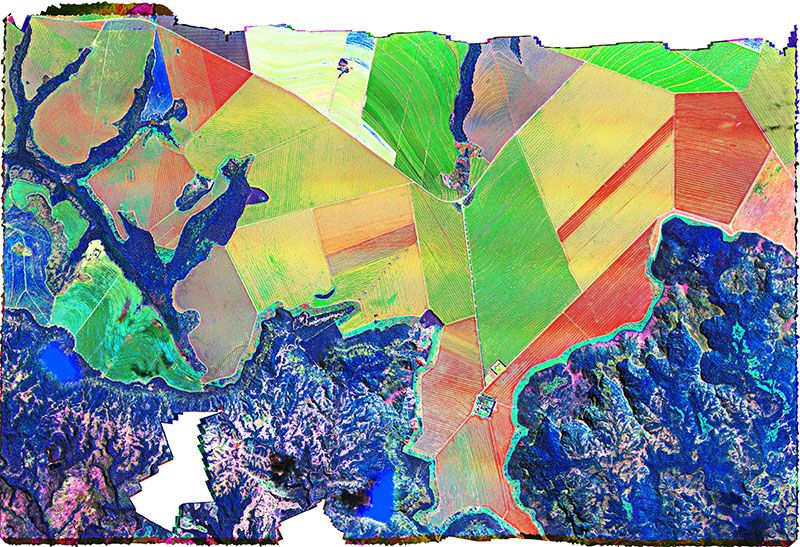Gamaya launched in 2015 to bring high-tech imaging and analytics solutions to industrial-size farms. A new partnership with Indian tractor manufacturer Mahindra & Mahindra and €10.9 million ($12.1 million) in fresh capital is going to shift the Swiss company’s focus the other way, to small-scale farms.
This week Gamaya closed its SFr21 million ($12.1 million) Series B round of funding, led by Mahindra and involving existing investors ICOS Capital and VI Partners.
Gamaya’s platform uses hyperspectral imaging, embedded cameras, and artificial intelligence to provide farmers and their advisors with deep insights about their operations. One example is helping farmers scout for pests and disease before they spray so they know where to spray before it presents an unfixable problem. “If you have large fields and outbreaks happening continuously, you’d need to scout everyday, so we provide service where we help farmer identify outbreaks early on,” said Igor Ivanov, chief operating officer at Gamaya. The firm also spots planting gaps for sugarcane growers to optimize the use of their land.
Offering an analogy with human health, Ivanov tells AFN that it’s difficult to use health indicators such as blood pressure, heart rate and temperature to diagnose anything more precise than being sick or not. “At Gamaya, we’re going beyond those high-level vitals into the equivalent of an MRI. We still need a doctor—the agronomists that spend time on the ground with farmers—but we can provide them with all the information they need in a customized, crop-specific set-up.”
Mahindra, a large manufacturer of farm equipment, naturally has a bigger focus on smallholder farmers that make up the vast majority of India’s agriculture sector, so its machinery tends to be smaller than in the US or Brazil where landholdings are larger.
Gamaya has focused on large-scale growers until now, with its biggest market Brazil. With this strategic investment, Gamaya will now get access to smallholders who typically cannot afford to purchase such high tech digital tools, as Mahindra will embed the platform into its tractors. Mahindra already has some digital agriculture services including a digital advisory app MyAgriGuru, which provides daily decision-making information to farmers as well as Tringo, a farm equipment rental marketplace.
“Bridging the gap between large-scale industrial production in places like Brazil and smallscale farmers is a challenge. If it’s not Mahindra who could help us resolve that, then we don’t know who could,” said Ivanov.
Partnerships like this with Mahindra demonstrates Gamaya’s recognition of the commercialization challenges for startups to deploy tech on farms.
“The reality is a lot of companies and investors in this space approach this problem from a tech point of view. But in agtech the main word is agriculture, and agriculture is very local,” he explained.
Its approach is to work with a limited number of partners to develop solutions that can be coupled with their partners’ offerings. “We are still an agtech company, but we’re looking for partners to complement our tech with agronomy and market access. We don’t necessarily want to compete on a local agronomy level.”
Gamaya will use the funding from this latest round to continue investing in product development and demonstrate use cases with partners that show the scalability and robustness of its technology, says Ivanov. “In remote sensing, scalability has not yet been proven beyond general health indicators such as the NDVI index,” he said.
“Hyperspectral imaging is very complex technology. You work with an enormous amount of information,” he continued. One of the most difficult issues is calibration—ensuring that changing field and weather conditions don’t jeopardize the accuracy of the data collected. “It took us three years working on calibration alone. When we embarked on this, I don’t think we realized how complex it would be.”
The Gamaya team believes commercialization is attainable, however, and coinciding with its funding close, Gamaya has brought on a new chairman in the form of ex global head of marketing at Syngenta Rob Neill.
“I’ve been at the forefront of innovation in crop protection throughout my career,” said Neill in a press release. “Digital technologies are the next wave of innovation and I believe they will truly transform food production worldwide.”
He continued: “I am delighted to join Gamaya at such a pivotal time, and I look forward to helping the company take its place among the global leaders in this exciting new field.”




